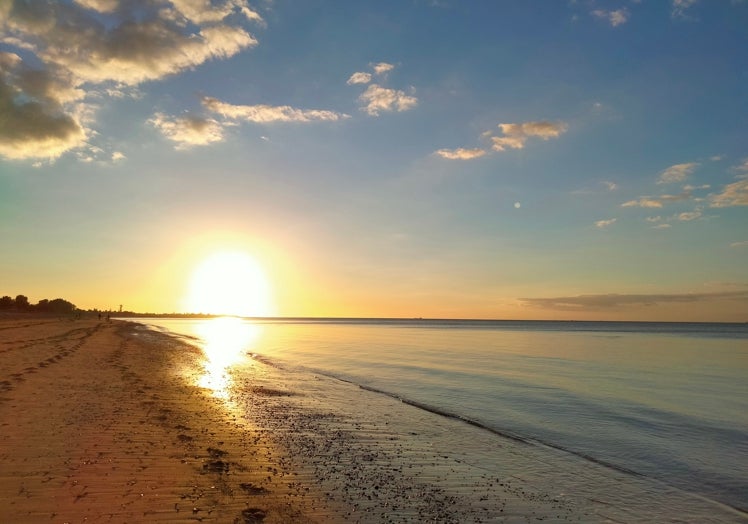‘Baños de ola’: the origins of beach holidays in Spain
The custom of bathing in the sea did not begin on the Mediterranean coast, but in the north of the country. San Sebastián and Santander were pioneers of beach tourism, which originated in the UK
Alekk M. Saanders
Santander
Friday, 4 July 2025, 12:54
In the 18th century, the benefits of bathing in the sea were scientifically confirmed. During that period, the first facilities for bathing in the sea were created in the seaside town of Scarborough in North Yorkshire, offering rolling bathing machines. Wooden carts with a roof and walls allowed people on the beaches to change into swimwear and return to their normal clothes.
Men and women usually bathed separately to avoid seeing people of the opposite sex in swimming costumes. As the pioneers were members of high society, there was a special etiquette in sea bathing.
Sea bathing is a royal affair
There is a legend that during his stay in Scarborough, King George I of Great Britain and Ireland was seen among the sea bathing enthusiasts.
In Spain it was the queen Isabella II who was fond of sea bathing, or rather, simply followed the recommendations of her doctor who advised her to go to the beach to alleviate some skin problems.
This is how a wooden hut came to be located on the picturesque city beach of La Concha in San Sebastián. By that time, this Basque city had already been a favourite resort of the royal family, but under Isabella II it became a place for natural cures.
It is believed that after bathing in the Bay of Biscay, the queen's skin diseases improved. San Sebastián eventually became a meeting place for the aristocracy and high society, who liked to swim in the sea or (as the Spanish called it) enjoy the ‘baños de ola’ (wave baths).
-U62312842456awX-748x524@Diario%20Sur.jpg)
In the mid-19th century, the flourishing commercial port of Santander was considered the centre of beach recreation. In fact, it was not surprising, because the capital of Cantabria was economically closely connected with Great Britain, and many English people often visited and settled in this city sharing their customs and habits with locals.
The local newspapers also actively promoted sea bathing, emphasising the many healing properties of the sea water. El Sardinero was the first beach to specialise in sea bathing, with two wooden huts (for ladies and gentlemen) with several isolated rooms located some distance from each other. Lunch and snacks were also offered there.
The capital of Cantabria was economically closely connected with Great Britain, and many English people often visited and settled in this city sharing their customs and habits with locals
Since few people could swim, an anchor tied to a rope was thrown into the water so that bathers could hold on to it and wade into the sea. The person in charge of the rope on the shore was called a ‘maromo’. For greater safety, a boat with trained personnel was nearby to help those who fell off the rope.
-U36100518514MZf-748x524@Diario%20Sur.jpg)
There was also a beautiful cast-iron pavilion on the seafront to receive people arriving by carriage from the centre of Santander. Sea bathing became a new trend, and thousands of wealthy people from Madrid and other representatives of the Castilian bourgeoisie also began to arrive en masse on the Cantabrian coast by omnibus, as there was no railway.
Spreading in the south
‘Wave bathing’ spread all along the Cantabrian coast and gradually moved south to Barcelona to continue down the Mediterranean coast. One of the most fashionable beaches on the Mediterranean coast was in Cullera (30 km from Valencia), located near the mouth of the river Júcar. It was called in English - ‘Júcar Beach’, thus giving it an international flavour.
In contrast to the cold waters of the north, the coastal destination of Andalucia offered places with warmer seawater, almost year-round sunny weather, as well as wines and horseback riding
As for Andalucia, one of the first beaches intended for bathing in the sea was proclaimed to be in Puerto de Santa María in Cadiz province. Huelva, a region with a high concentration of English people, was also advertised as the healthiest place in Spain for sea bathing. At that time, the beach at Punta Umbria gained fame as the most beautiful beach in Europe.

In contrast to the cold waters of the north, the coastal destination of Andalucía offered places with warmer seawater, almost year-round sunny weather, as well as wines and horseback riding. Steamboats on the river between Seville and Sanlúcar de Barrameda took noble holidaymakers to the coast from the Andalusian capital. The railway also contributed to the popularisation of sea bathing in Andalucia.
-RMDmGqoFPM0fnzC7NIwKsZO-1200x840@Diario%20Sur.jpg)